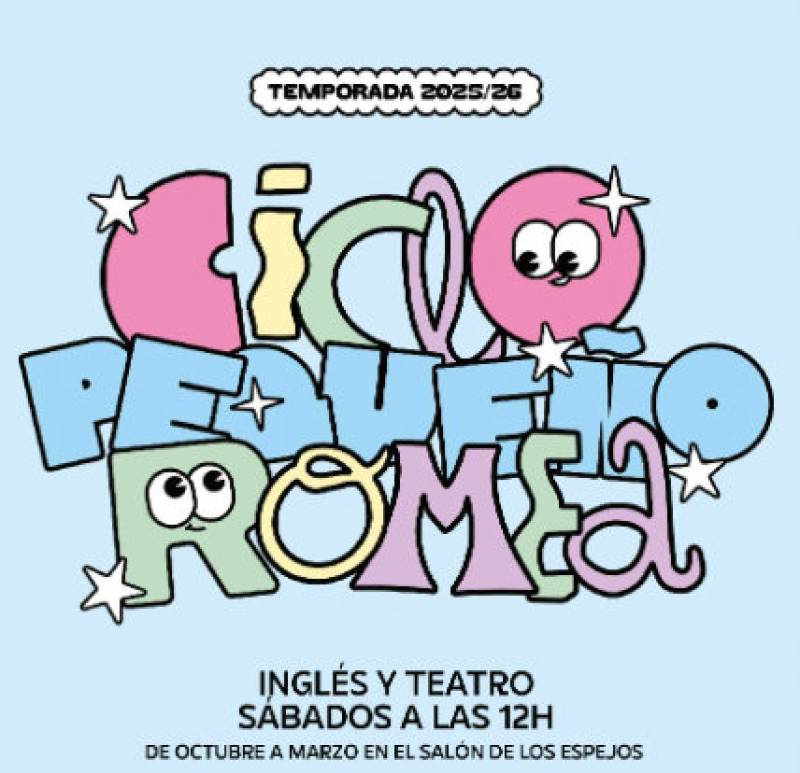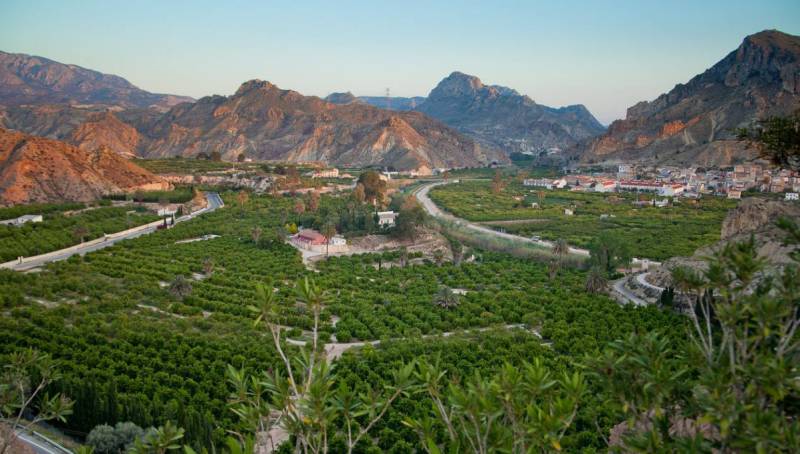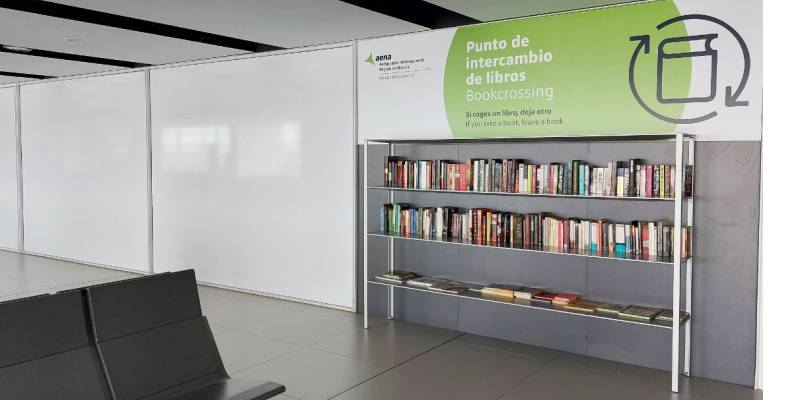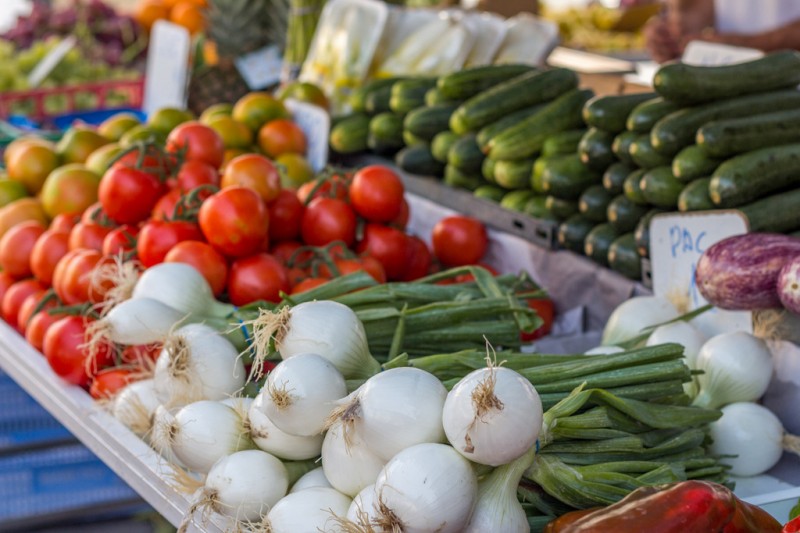
To be listed on the haciendadelalamo TODAY MAP please call +34 968 018 268.
The Salzillo Museum, Museo Salzillo, Murcia
The Salzillo Museum celebrates the work of Francisco Salzillo
The Museo Salzillo, the Salzillo Museum
Francisco Salzillo is a name synonymous with Baroque sculpture in Murcia, working at a time when the exuberance and drama of Baroque art and architecture was changing the city during a period of notable economic and social expansion.
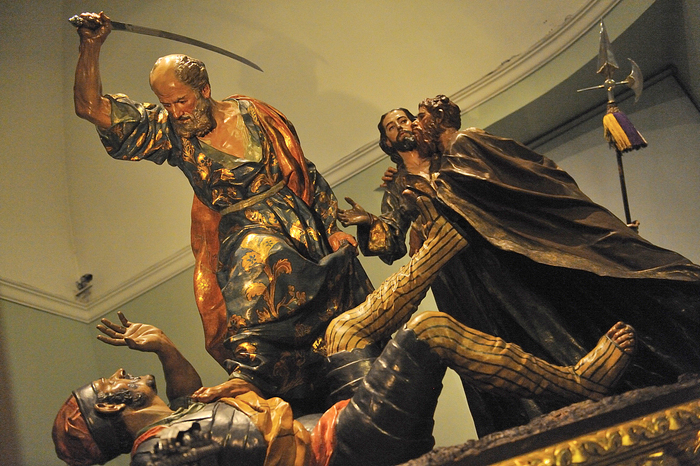
Click here to read an introduction to Francisco Salzillo, Click Francisco Salzillo
Salzillo is recognised as the most important sculptor working in Murcia during this period and a museum has been dedicated to his lifetime and works, incorporating the Iglesia de Nuestro Padre Jesús Nazareno, the headquarters of the Real y Muy Ilustre Cofradía de Nuestro Padre Jesús Nazareno. This Cofradía owns some of the most important remaining works by Salzillo, the pasos (sculptures) carried in the Good Friday 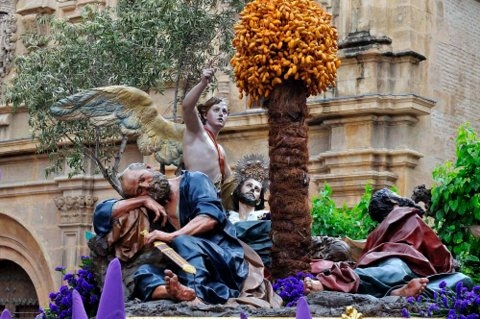 procession of Semana Santa ( Easter week), known as La Procesión de los Salzillos, the procession of the Salzillos. This is one of the most important processions of the Easter week, and is certainly one of the most popular for spectators.
procession of Semana Santa ( Easter week), known as La Procesión de los Salzillos, the procession of the Salzillos. This is one of the most important processions of the Easter week, and is certainly one of the most popular for spectators.
If attending the procession is not an option, then make a point of visiting this museum to guage a feeling of the artist and the power of the pasos, strong, exuberant and expressive examples of the best in Baroque sculpture.
Also on display is an extensive Belén, a traditional nativity scene sculpted for the Marqués de Riquelme, a magnificent work comprising 556 pieces which is one of the most important beléns in Spain and certainly the most significant in Murcia.
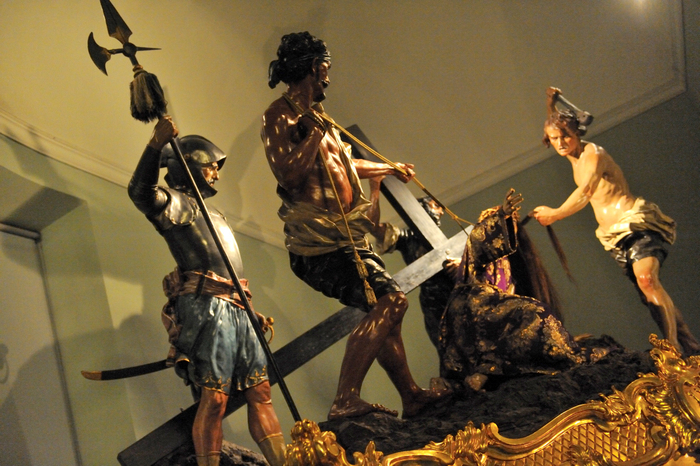 The Salzillo Museum, Museo Salzillo
The Salzillo Museum, Museo Salzillo
Plaza san Agustin, 3
Click for map, Museo Salzillo
Tel 968 291 893
Opening hours
Winter:
Moday to Saturday 10am to 5pm
Sundays 11am to 2pm
Summer:
Monday to Friday 10am to 2pm
Saturday and Sunday closed
There is an entry fee and the museum also has a well stocked gift shop. There is underground car parking nearby and plenty of restaurants and bars: it is worth noting that in this area there is a substantial immigrant population and there are some excellent restaurants serving comfortable and practical south-American meals.
A Visit to the Museo Salzillo
This museum is well structured and logical, with excellent information boards in dual languages.
The museum follows a logical course, exploring the works of the sculptor, the development of Baroque 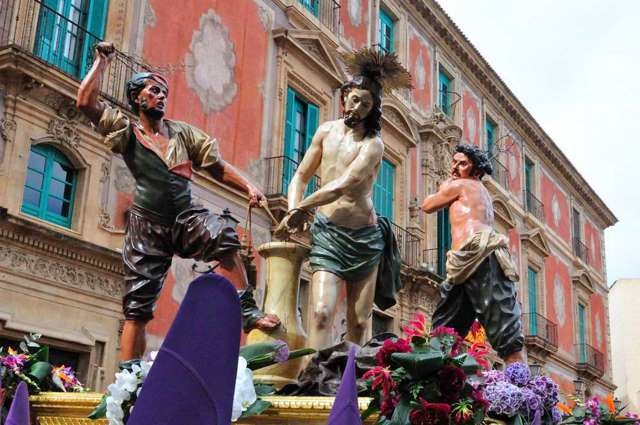 architecture and artworks in Murcia and the róle played by his masterpieces during Semana Santa.
architecture and artworks in Murcia and the róle played by his masterpieces during Semana Santa.
The Baroque movement of which Salzillo is so representative, was, to put it simply, born of a 16th Catholic canon, the Council of Trent (1543-63) which dictated that paintings and sculptures used within the context of religious art should speak to the illiterate rather than the well informed, the spawning of which was the effusive and directly simple depictions favoured by the Baroque. The movement is obvious, dramatic, bold and splendid in its exuberance and detail, glorifying God in the most shameless and expressive style.
This era was visual and bold, worshippers imbued with the glory of God by acres of gold leaf employed in triumphant alterpieces soaring to the heavens, luxurious decoration, effusive embellishing and pious saints, all in glorious colour and luxurious detail.
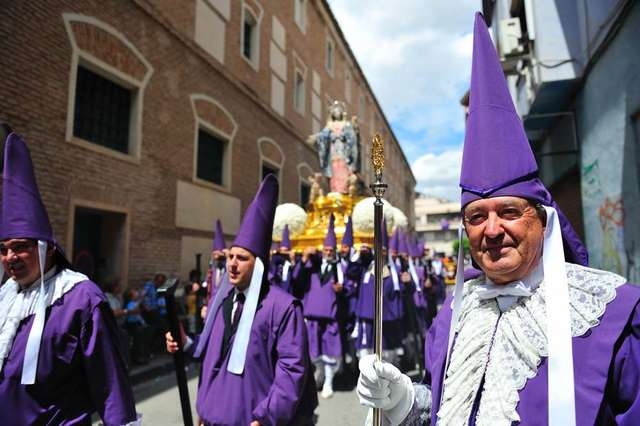 Churches and Cofradias competed to honour their God in the most splendid manner possible, and Salzillo was the superstar of the sculptural world, his pieces the prize possessions of those who so proudly bore them through the streets as a symbol of the wealth and prestige of their Cofradia.
Churches and Cofradias competed to honour their God in the most splendid manner possible, and Salzillo was the superstar of the sculptural world, his pieces the prize possessions of those who so proudly bore them through the streets as a symbol of the wealth and prestige of their Cofradia.
This first section celebrates the rich robes worn by the original pasos, embellished with the silk produced in Murcia. The orchards which surrounded the city were a source of wealth, thousands of small silkworm producers nurturing a rich crop of silk, a major source of income and wealth for the Murcian economy. The display focuses on the rites of Semana Santa and the specially commissioned pieces which celebrated the wealth and prestige of the Cofradías and their patrons, tantalising glimpses of the church beyond the standards and processional pomp, the baroque desire for theatrical splendour celebrated by the skill of Salzillo.
The second sala is known as the Sala de los Bocetos. This includes a collection of terracotta models (bocetos) made by the sculptor and belonged to Sánchez Tapia, a murcian sculptor who was a great admirer of Salzillo.
It´s incredibly rare for pieces like this to have even survived, and it is due purely to the esteem in which this 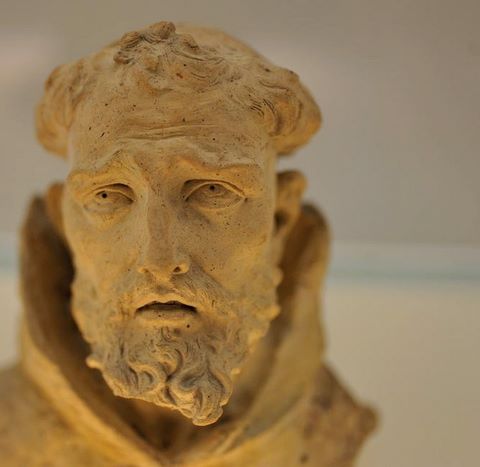 sculptor held Salzillo, that they survived at all. These pieces are in fact the miniature scale models made of larger pieces which the sculptor planned to execute and were an essential component in the process of creating full scale pieces.These small models are an invaluable tool for students, offering an intimate insight into the techniques used by Salzillo and his process of thought when creating his masterpieces.
sculptor held Salzillo, that they survived at all. These pieces are in fact the miniature scale models made of larger pieces which the sculptor planned to execute and were an essential component in the process of creating full scale pieces.These small models are an invaluable tool for students, offering an intimate insight into the techniques used by Salzillo and his process of thought when creating his masterpieces.
When a commission was received for a piece, preliminary drawings would be prepared, from which a small terracotta model was then formed. This would enable the sculptor to amend the position of limbs or the inclination of a head or hands. From this the final working model could be prepared, gridded up to enable the sculptor to accurately reproduce the model full scale.
In this room, visitors can see the tools used in the creation of these pieces, together with a selection of the original terracotta models, some clearly marked up with the lines from which the sculptor would work.
The Belén
The magnificent Belén or nativity scene was made by Salzillo for the nobleman Jesualdo Riquelme y Fontes, comprises 556 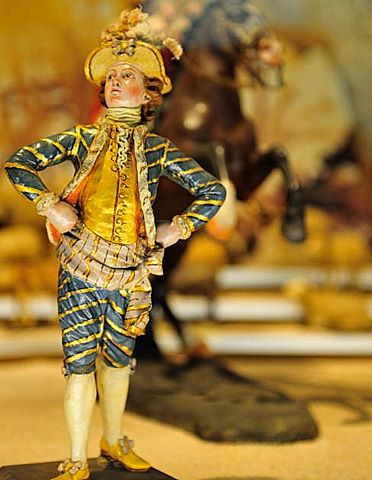 pieces and was made in the last years of Salzillo´s life between 1776 and 1783. Although part of the Belén was undoubtedly made by Salzillo during his lifetime, many of the pieces were made after his death by his star pupil Roque Lopéz, who emulated the style of Salzillo, but brought his own dynamism and personality into his own pieces, completing the final elements as the century ticked over in 1800.
pieces and was made in the last years of Salzillo´s life between 1776 and 1783. Although part of the Belén was undoubtedly made by Salzillo during his lifetime, many of the pieces were made after his death by his star pupil Roque Lopéz, who emulated the style of Salzillo, but brought his own dynamism and personality into his own pieces, completing the final elements as the century ticked over in 1800.
It's a remarkable piece of work, not only a piece of great religious and artistic significance but a window into Murcian life and the characters Salzillo would have seen around him in the City at that time.
He is said to have invited rag bedecked blind beggars to his studio so that he could model them accurately, and the lavishly dressed huntsmen shooting wildfowl in the marshes, together with their hunting dogs and beaters are known to be authentic portraits of the count himself and his aristocratic friends.
Every aspect of Murcian life is represented, from the slaughterman killing and skinning sheep for the evening meal, to the marketplaces selling fresh fruit and vegetables and the old man sitting in rags by a fire.
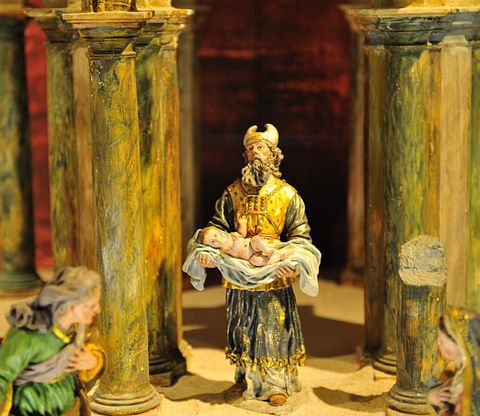 Silk clad court attendants strut through the palace grounds whilst women fight to save the lives of their offspring from the slaughter of the innocents, sleeping shepherds are visited by delicately modelled angels and daily life goes on whilst the drama of the nativity unfolds.
Silk clad court attendants strut through the palace grounds whilst women fight to save the lives of their offspring from the slaughter of the innocents, sleeping shepherds are visited by delicately modelled angels and daily life goes on whilst the drama of the nativity unfolds.
During 2014 the museum gained a second Belén, this one in a completely different style and known as the "Neapolitan Belén. " Click to see images of the Napolitan Belén
The Neapolitan nativity scene in the Museo Salzillo
Click to see images of the Napolitan nativity scene
The Neapolitan nativity scene was collected over decades by Carmelo and Emilio García de Castro, and was acquired for the museum by the the Fundación San Antonio for an undisclosed sum.
The 18th century collection is considered to be one of the finest of its type in the world, along with those belonging to the March Foundation in Palma de Mallorca, the Certosa di San Martino in Naples and the national museum of Bavaria in Munich. The pieces in the collection are large and remarkable for their technical perfection and realism as well as the quality of the materials used, and the same is true of the scenery in which they are displayed, which is a combination of biblical and 18th century elements. The belén is characterful and ebullient in its detail, full of larger than life characters and personality, and crammed full of detail. Some of the figures previously belonged to the Borbón royal family and the personal collection of Carlos III, and others created by the Neapolitan master Giuseppe Sanmartino are also included.
Moving out of the sala and into the Iglesia itself there are two figures of particular importance en-route, La Santa Mujer Verónica (1755)and San Juan Evangelista, (1756) both of which participate in the Good Friday procession.
Iglesia de Jesús, The pasos of Holy Friday, the procession of the Salzillos.
 Inside the church are 5 Pasos by Salzillo and one by Juan de Aguilera, the figure of Christ with the cross, Nuestro Padre Jesús.
Inside the church are 5 Pasos by Salzillo and one by Juan de Aguilera, the figure of Christ with the cross, Nuestro Padre Jesús.
1754 Oración en el huerto
One of the most famous works by Salzillo. it is composed of two groups; one the angel holding up Christ, and in the other three of the apostles sleeping. Angels were habitually presented by Salzillo as being if indeterminate sexuality, with beautiful faces and a serene air of untouchable beauty.
In this group the three apostles are shown with distinctive characteristics- San Juan sleeping deeply, head on outstretched arm, Santiago bearing the weight of the world on his shoulders in uneasy sleep, and San Pedro even though asleep, still in a state of watchful and protective alertness.
1752 La Caida, the fall
In this group Jesus falls, guarded by a soldier wearing 17th century armour, two executioners and Simon of Cyrene.
1763 The Last Supper
 This piece weighs 1362 kilos, and is carried by 28 Nazarenos in the Good Friday procession. It´s an imposing large-scale representation and at the time of manufacture cost 27,749 reales, equivalent to 6.937 pesetas, which was a vast sum of money at the time.
This piece weighs 1362 kilos, and is carried by 28 Nazarenos in the Good Friday procession. It´s an imposing large-scale representation and at the time of manufacture cost 27,749 reales, equivalent to 6.937 pesetas, which was a vast sum of money at the time.
Showing Jesus and his twelve disciples, sharing the last supper, it is lavishly decorated with food, fruit and flowers for the annual Good Friday procession, and is remarkable for the expressions of the disciples, its intimate detail and personality, and vivid sense of interchange between the protagonists.The sculpture has been fully restored and is fresh and alive, with vivid colours, a far cry from the dark smoke-stained tones before it underwent restoration.
The Prendimiento, The capture of Jesus, 1765
 Another of the best-known Good Friday pasos, this shows Jesus in the Garden of Gethsemene, the figures of Jesus and Judas Iscariot bound in a single block of wood in the act of betrayal. The symbolism of the two figures joined in an act of inevitability, Jesus calm and impassive as he accepts the kiss which condemns him. Detached, are San Pedro, Malco and a Roman Soldier, the rage and impotence of Saint Peter in every sinew of his body, blood vessels straining as he brandishes a sword in fury over the servant Malco, a dramatic, powerful piece, laden with anger and tension.
Another of the best-known Good Friday pasos, this shows Jesus in the Garden of Gethsemene, the figures of Jesus and Judas Iscariot bound in a single block of wood in the act of betrayal. The symbolism of the two figures joined in an act of inevitability, Jesus calm and impassive as he accepts the kiss which condemns him. Detached, are San Pedro, Malco and a Roman Soldier, the rage and impotence of Saint Peter in every sinew of his body, blood vessels straining as he brandishes a sword in fury over the servant Malco, a dramatic, powerful piece, laden with anger and tension.
1777, Azotes
This is the last piece made for the Cofradía de Nuestro Padre Jesús Nazareno, at a time when Salzillo was aging, much of the work attributed to him was being produced by his workshop and most of his commissions were coming from outside of the capital.
Although it is a strong and dramatic piece showing the flagellation of Christ, it lacks his characteristic detail and tension, Christ passively accepting his torment. Typically of Salzillo, those beating Christ are wearing Murcian dress contemporary with the date of the sculpture.
Churches in Murcia which contain works by Salzillo
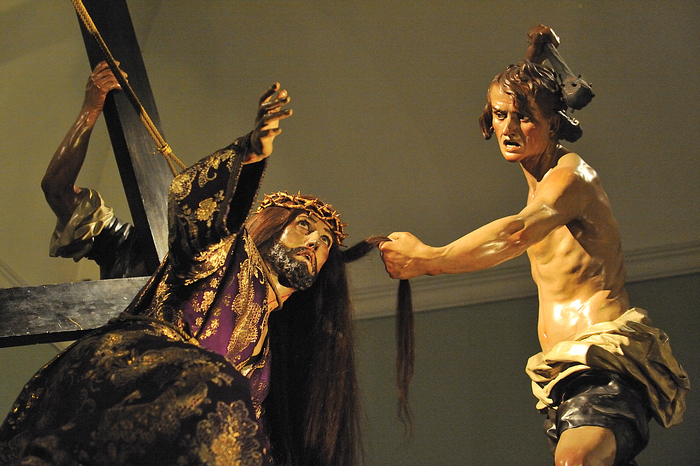 If you are interested in discovering more about the works of Salzillo and seeing more of his pieces, you may enjoy tying a visit to the museum in with a visit to one of the churches which hold his works.
If you are interested in discovering more about the works of Salzillo and seeing more of his pieces, you may enjoy tying a visit to the museum in with a visit to one of the churches which hold his works.
The nearest one to the museum is the Monasterio y Iglesia de las Agustinas de Murcia, about a 2 minute walk away.It has a bold figure of San Agustin by Salzillo and a beautiful figure of Saint Cecilia delivered by Roque López, Salzillo´s most important pupil, in the year of Salzillo´s death, although now attributed entirely to López. It is only open during mass, so click here to find out more information, Monasterio y Iglesia de las Agustinas de Murcia
There are many other works by Salzillo scattered across Murcia and in the neighbouring province of Alicante in the Comunidad Valenciano, along with others claiming to be Salzillos, but are of dubious provenance. Tragically many of the works by the master were destroyed during the Spanish Civil War, a great legacy which went up in smoke as churches and their contents were burnt in 1936-7.









